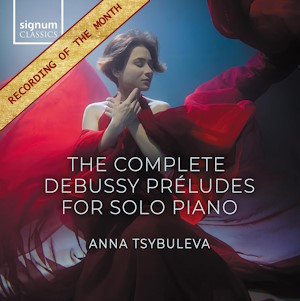
Claude Debussy (1862-1918)
Préludes Book 1 (1909/10)
Préludes Book 2 (1912/13)
Anna Tsybuleva (piano)
rec. 2022, Turner Sims, Southampton, UK
Signum Classics SIGCD911 [83]
Many composers have completed cycles of 24 préludes and the usual idea behind that number is that there are 24 major and minor keys; Bach, Chopin, Alkan, Rachmaninov and Scriabin all adhere to this scheme, neatly providing one prélude for each key albeit rather haphazardly in Rachmaninov’s case. Debussy’s two books of twelve, written just a few years apart, break from this idea and are also unusual in that they are each given a title, though that title appears at the end of the piece not as a header; as E. Robert Schmitz observes in his book the Piano works of Claude Debussy the composer makes it clear that the music is of first importance and a stimulus to its added enjoyment is only an afterthought, a helping hand for those who need it and a confirmation for those who are wavering and of no importance to those who have found their own thoughts so completely in the music. As a guide they are perfect and if they leave questions – who was the girl with the flaxen hair and who’s footprints were in the snow? – these are no more than could be asked about any descriptive title; it is up to the listener to fill in the details from the evocative power of the music.
Several of the préludes remain amongst Debussy’s most popular works and it is the richness and imagination of his writing that has kept them there. The number of recordings reflect this popularity and one can choose complete sets from Walter Gieseking, Monique Haas, Arturo-Benedetti Michelangeli and, more recently Francesco Piemontesi, Pierre Laurent Aimard or Vanessa Bonelli Mosell amongst many others. Anna Tsybuleva is joining a fairly crowded market but this Leeds competition winner shows that she can hold her own alongside the best. Her sustained line in Danseuses de Delphes avoids the stiff formality that some choose to adopt and she adds glorious pedalling to this in the veiled landscapes of voiles. She pedals lightly in la vente dans la plaine but still achieves clarity and a lightness of touch that shines throughout the recital; in the joyful freedom of les collines d’Anacapri, the quirky humour of la sérénade interrompue and General Lavine – Eccentric or the light-hearted impishness of Puck’s danse. She coaxes wonderful colours from the instrument – presumably a yamaha as she is a Yamaha artist – and its rich bass adds to the magic of La cathèdrale engloutie; her sound in the final C major section, its muted tones so different to the rest of piece, is beautifully judged. If one was to mention the timbre of bells so skilfully created by Debussy I would want to highlight the crystal ringing that Tsybuleva brings to the marqué chords in the B major section. Minstrels is all gruff humour but there is a tender side in the gentle rubato of the mini serenade at the heart of the piece. The ethereal misty figures of Brouillards heard on the tail of Minstrels is quite striking; quite apart from the disparate subject matter Debussy’s second set of préludes is more securely immersed in the harmonic world that he explored in book one and there is a clear progression leading to his next major piano collection, the twelve études. Indeed the final two préludes of the second book are something of a bridge into that world; les tierces alternées, alternating thirds, is an étude in all but name and Feux d’artifice is well known for its technical demands. Tsybuleva is undeterred by their technical challenges and moulds the shimmering thirds admirably though I like the frisson that Hamelin brings to his faster performance (Hyperion CDA67920 review). Elsewhere she impresses with her vivid evocation of the hustle and bustle of the busy square by the gate of the Alhambra, La Puerta del Vino, inspired by a postcard from his friend Manuel de Falla and with the perfect stillness and sense of timelessness in the enigmatic moonlit scene la Terrasse de audiences du clair de lune. There is a wonderful judged rubato in the slow waltz at the heart of les Fées sont d’exquises danseuses coupled with the same leggiero touch that we heard in earlier préludes.
This is as good a recording of these pieces as I can imagine and the personal connection that Ms Tsybuleva describes in her introduction, telling of her mother playing the girl with the flaxen hair to the five year old Anna, shines through in every bar. Recorded in utterly glorious sound this is a worthy addition to the great sets that have gone before.
Rob Challinor
Buying this recording via a link below generates revenue for MWI, which helps the site remain free




















